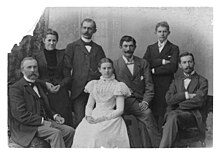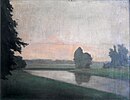Walter Queck
Walter Queck (born December 15, 1871 in Annaberg , † March 7, 1906 in Meran ) was a German painter .
Life
origin
The son of a wealthy Erzgebirge family grew up in the Leipzig suburb of Lindenau since 1878 . His father, Hermann Queck (* July 4, 1839 in Eibenstock , † May 28, 1911 in Leipzig), was the last community leader there before it was incorporated into Leipzig. Walter had four siblings.
education
Walter Queck studied painting at the Royal Art Academy in Leipzig. From there he moved to the Art Academy in Munich , where he was a student of Karl Raupp (1837–1918) and Simon Hollósy (1857–1918).
Creating art
After completing his studies, Queck worked as a portrait and landscape painter in Munich. He was in close contact with the Munich painters' circles. He had a particularly close artistic friendship with Wilhelm Stumpf , Paul Horst-Schulze and Walther Caspari . Numerous study trips took him to Hungary , Tyrol , Northern Italy and Dalmatia .
In 1897 Walter Queck returned to Leipzig from Munich. Here he quickly developed into a sought-after portraitist among the Leipzig bourgeoisie. To support his portraits, he made drawings of his models in addition to drawing studies. He also gave painting lessons to women. The years 1902 to 1904 were the artist's most productive phase. In 1903 some paintings were exhibited in Berlin. The oil painting Flutkanal am Ritterwerder and the picture Leipziger Markt were published as postcards by a Leipzig publisher and with other pictures as art prints in the Leipzig calendar, an illustrated yearbook and calendar (years 1904–1907).
Starting a family, death
After initially having his studio in the Leipziger Künstlerhaus , he had the architect Paul Möbius (1866–1907) build a house with a studio in Leipzig- Leutzsch , Laurentiusstraße 1, in 1901/1902 . The description speaks of a "cozy house built for two people". Shortly after Mercury's marriage with Johanna geb. Landmann (* 1878) both moved into the house. They had two daughters, Jutta (1903–1996) and Ursula (1904–2002).
Queck fell ill with tuberculosis as early as January 1902 . During a spa stay in South Tyrol he died in March 1906 at the age of 34 in Merano. After his body was transferred to Leipzig, he was buried on March 13, 1906 in the Lindenau cemetery. Eight months later, the widow decided to purchase a representative hereditary burial in the Leipzig South Cemetery . On November 19, 1906, the coffin of Mercury was reburied there. Johanna Queck commissioned the architect Paul Möbius to design a tomb with reliefs by the sculptor Felix Pfeifer (1871–1945), which, like the house in Leutzsch, is considered a masterpiece of Art Nouveau in Leipzig.
Works (selection)
- Self-portrait
- Portrait of Hermann and Ernestine Helene Queck (parents)
- Portrait of Gebhard Fugel , 1894
- Portrait Arthur Nikisch , 1900
- Landscape in Oil, around 1900
- Landscape in Hungary , watercolor around 1900
- Flood canal at Ritterwerder , around 1900
- Landhaus Queck in Leutzsch , oil on cardboard, around 1903
- Portrait of Hermann Kretzschmar , 1904
- Market in Leipzig in winter , 1904
- Portrait of Ferdinand Goetz , 1905
- Portrait of Dr. med. Stump, 1905
- On the Karl Heine Canal , drawing 1905
Image examples
Portrait Arthur Nikisch
literature
- Alfred E. Otto Paul: The art in silence. Art treasures in Leipzig cemeteries . Vol. 2, private print by the Paul Benndorf Society , Leipzig 2010.
- Walter Queck . In: Ansgar Scholz, Annekatrin Merren: The fairy tale house . In: Forgotten avant-garde. Künstlerhaus and Nikischplatz. ( Leipziger Blätter , special issue), Passage-Verlag, Leipzig 2016, ISBN 978-3-95415-055-7 , p. 58
Web links
- Walter Queck. In: Matriculation entry Academy of Fine Arts Munich. Retrieved July 2, 2020 .
- Image Villa Queck, Leipzig. Retrieved July 2, 2020 .
- The grave of the painter Walter Queck. Retrieved on July 2, 2020 (detailed description of the Walter Queck grave).
Individual evidence
- ↑ While Hermann Queck was still alive, a street in Leipzig-Lindenau was named after him. (Gina Klank, Gernoth Griebsch: Lexikon Leipziger Straßennamen . Ed .: Stadtarchiv Leipzig. 1st edition. Verlag im Wissenschaftszentrum Leipzig, Leipzig 1995, ISBN 3-930433-09-5 , p. 173 . )
- ↑ Architektonische Rundschau , Volume 21, 1905, Issue 8, p. 64 and Plate 62.
- ^ Johanna Queck married the reform pedagogue Karl Wilker in 1909 . This marriage ended in divorce in 1931. Her educational work was published in 1912 under the name Hanna Queck-Wilker by Verlag Hermann Beyer & Sons, Langensalza , under the title: A First Year of Life. Observations on a child from diary entries
- ↑ Ritterwerder was the southern part of the Leipzig palm garden, since 1917 Klingerhain
- ^ Franz Peter Felix Stumpf (1877–1964) was the brother of Walter Queck's painter friend Wilhelm Stumpf
| personal data | |
|---|---|
| SURNAME | Queck, Walter |
| BRIEF DESCRIPTION | German painter |
| DATE OF BIRTH | December 15, 1871 |
| PLACE OF BIRTH | Annaberg-Buchholz |
| DATE OF DEATH | March 7, 1906 |
| Place of death | Meran |










